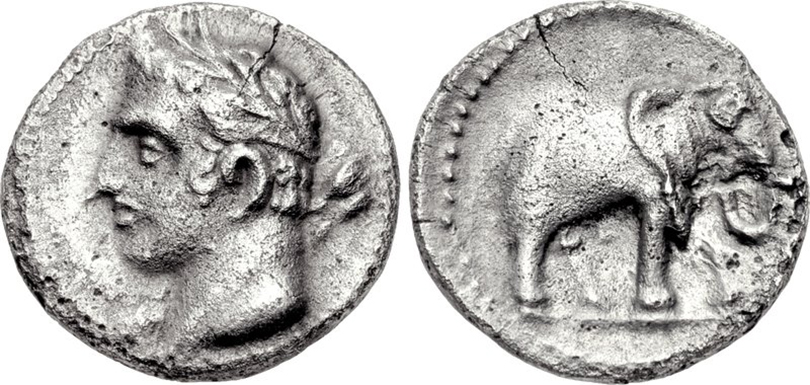
Image of Hannibal and his War elephant on a Spanish quarter-shekel, 237-209 BC
Hannibal university & Near-Conquest of Rome
Hannibal & His Near-Conquest of Rome is not mentioned enough in global history. He was (247-181 BC) an extremely bright general and statesman who commanded Carthage’s main forces against the Roman Republic during the Second Punic War. He is widely considered to be one of the greatest military commanders in human history. Hannibal learned much from his father, Hamilcar Barca, who was a leading Carthaginian commander during the First Punic War.
Hannibal lived during a period of great tension in the western Mediterranean Basin. It was triggered by the emergence of the Roman Republic as a great power after it had established its supremacy over Italy. Although Rome won the First Punic War, Carthagenians never accepted them as rulers. That sentiment was symbolized by the pledge Hannibal made to his father, never to be a friend of Rome.
The Second Punic War broke out in 218 BC after Hannibal’s attack on Saguntum, an ally of Rome in Hispania. He then made his famous military exploit of carrying war to Italy by crossing the Alps with his North African war elephants. In his first few years in Italy, he won a succession of dramatic victories at the Trebia, Lake Trasimene, and Cannae, the latter of which is considered one of the greatest tactical feats in military history.
Hannibal distinguished himself for his ability to determine both his and his opponent’s respective strengths and weaknesses, then plan battles accordingly. Hannibal’s well-planned strategies and tactics allowed him to conquer several Italian cities allied to Rome. His forces occupied most of southern Italy for 15 years. Undermanned compared to the Romans, he could not win a decisive victory, as the Romans led by Fabius Maximus, avoided direct confrontation with him. Instead, Maximus successfully waged a war of attrition, particularly since Hannibal had to re-supply on his opponent’s land.
A counter-invasion of North Africa led by Roman general Scipio Africanus, forced him to return to Carthage. At the end of the day, Rome had more resources and used some of Hannibal’s strategies against him. Scipio eventually defeated Hannibal at the Battle of Zama, having previously driven Hannibal’s brother Hasdrubal out of the Iberian Peninsula (Spain).
After the war, Hannibal successfully ran for the office of sufet. He enacted political and financial reforms to enable the payment of the war indemnity imposed by Rome. Those reforms were unpopular with members of the Carthaginian aristocracy and in Rome. That led Hannibal to flee into voluntary exile. During this time, he lived at the Seleucid court, where he acted as military advisor to Antiochus III the Great in his war against Rome.
Antiochus met defeat at the Battle of Magnesia and was forced to accept Rome’s terms, and Hannibal fled again, making a stop in the Kingdom of Armenia. His flight ended in the court of Bithynia. He was betrayed to the Romans and committed suicide by poisoning himself.
Hannibal is often regarded as one of the greatest military tacticians in history and one of the greatest generals of Mediterranean antiquity, together with Philip of Macedon, Alexander the Great, Julius Caesar, Scipio Africanus and Pyrrhus. Military historian Theodore Ayrault Dodge called Hannibal the “Father of Strategy”, because Roman armies adopted elements of his military tactics into their own strategic arsenal.
Though statues and busts of Hannibal exist in Europe, you can’t trust their accuracy. They do not exhibit North African features common to Carthagenians who lived in the area called Tunisia today. That is not surprising because Europeans crafted impossible images of Jesus Christs with light skin, blond hair and blue eyes, though his biological & geographical ancestry would clearly suggest bronze skin, dark curly-kinky hair and brown eyes. The 237-209 BC coin at the top of this page may be one of the best available images of Hannibal.
